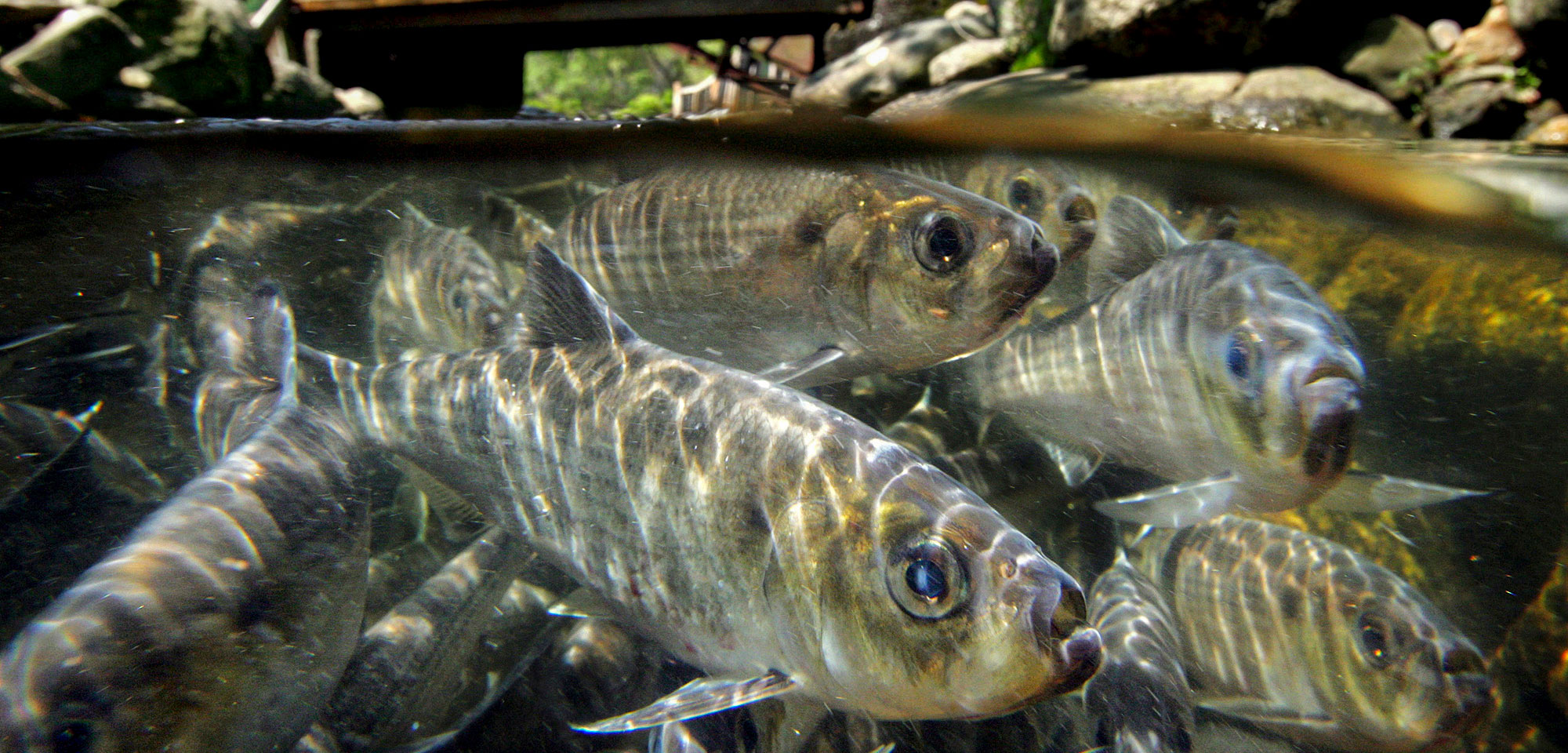Dammed but Not Doomed
As dams come down on the Skutik River, the once-demonized alewife—a fish beloved by the Passamaquoddy—gets a second chance at life.
Article body copy
Heroic fish tales tend to focus on species with a certain je ne sais quoi: the leaping salmon, the globetrotting tuna, the mammoth marlin towering above its captor as it dangles from a scale. Not so much the modest alewife, flashing in the sunlight as a teenager stands on a riverbank in northern Maine and threatens to stuff it down the back of their friend’s shirt.
But on a mild day in mid-May, alewife—one of two closely related species referred to collectively as river herring—are the undeniable center of attention. On the banks of the Pennamaquan River, students from schools at the nearby Passamaquoddy Nation communities of Motahkomikuk (Indian Township) and Sipayik (Pleasant Point), Maine, gather in groups for Alewife Day. Some wade into the water downriver from a dam to scoop migrating alewives from the churning rapids with long-handled nets, while on the bank, other students, alternating between quiet concentration and enthusiastic retching, divide the fish into buckets so a visiting scientist can teach them how to collect biological information. As he shows the students how to scrape scales from the alewives’ bodies, the scientist apologizes for making them gag. “That’s okay, we signed up for this,” a student replies.
From a vantage point on the dam just upriver, Ralph Dana, with Sipayik’s environmental department, surveys the action. Dana, who often ends his sentences with an upward lilt, as if his enthusiasm is carrying his words skyward, says he likes coming here because it’s so similar to the much larger river at the heart of Passamaquoddy territory: the Skutik, or St. Croix, one river to the north. “It really is a scale model of our river,” he says. Like the Pennamaquan, the Skutik has dams; it has fishways, watery ramps that help fish swim around obstacles; and it has alewife, which, as Dana has spent the morning telling students, are in trouble.
Every spring, runs of alewife (siqonomeq in Passamaquoddy)—a slender, shoebox-length fish suited to charging against the current—navigate from the Atlantic Ocean to the freshwater habitats where they spawn, traveling up rivers and streams across northeastern North America. The Skutik, which begins at a group of lakes puddled along the Maine–New Brunswick border and runs 185 kilometers along the international boundary to Passamaquoddy Bay, plays a particularly important role in this migration: the river once supported what was the largest run of alewife in Maine, and potentially on the continent, a coursing silver line connecting the fresh water and the sea, some 80-million-fish strong.
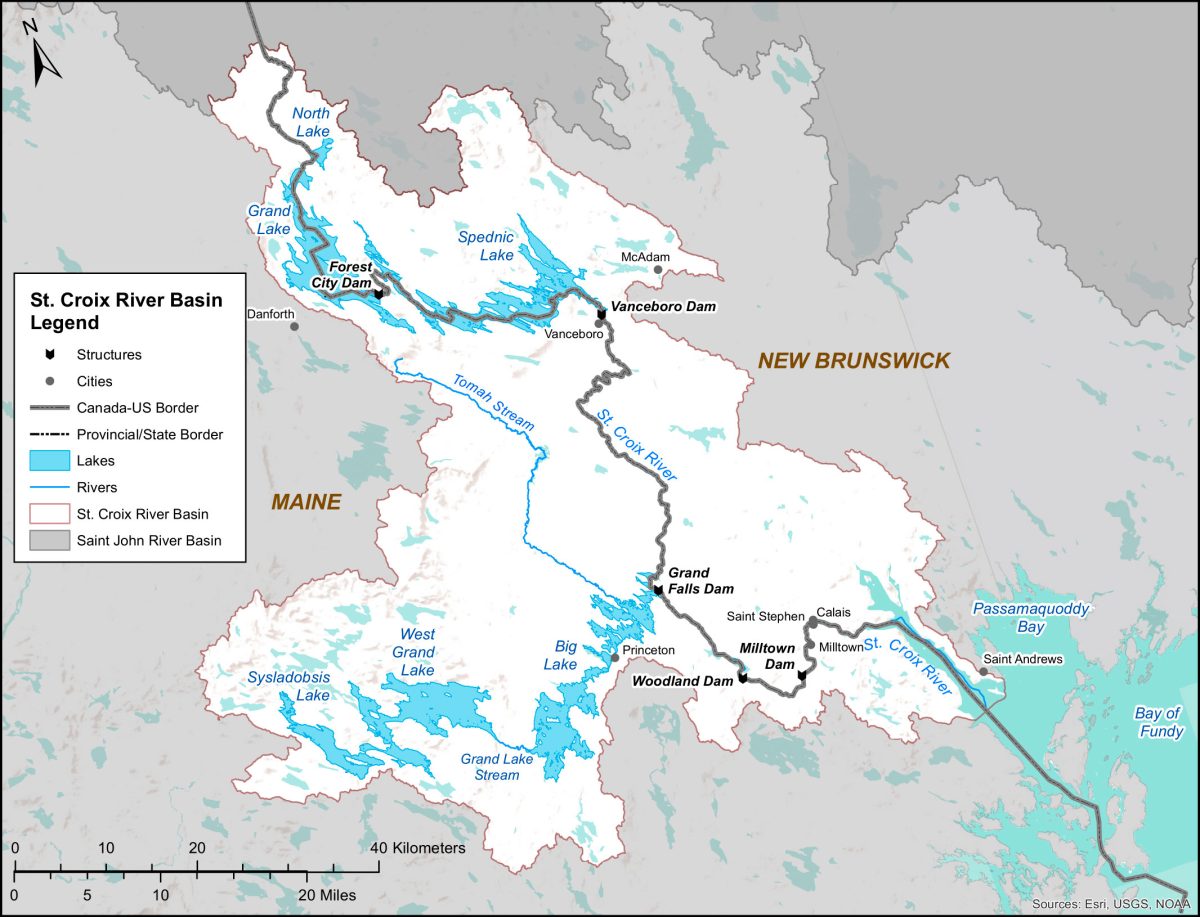
The Skutik (St. Croix) River runs along the United States–Canada border on the East Coast for 185 kilometers. Creation of the border split the Peskotomuhkati Nation. Now, the Passamaquoddy Nation on the US side of the river and the Peskotomuhkati Nation on the Canadian side are working together to restore runs of alewife, a fish that was integral to their way of life for thousands of years. Map by the International Joint Commission
For the Passamaquoddy, a nation of approximately 3,500 people whose territory straddles the Canada–United States border, the abundance of alewife in the Skutik River supported a way of life stretching back millennia. (Archaeological work in the territory has found alewife bones in charcoal pits dating back 4,000 years.) But over centuries, the Passamaquoddy were forced off their territory, even as dams blocked the passage of alewife upstream. At one point, barriers threatened to wipe alewife out from the river altogether.
After years of effort led by the Passamaquoddy, alewife are now poised to recover. Last summer, work began on the most significant step yet: removal of the Milltown Dam, the first barrier fish encounter when migrating upstream. That work is expected to be completed in 2024.
Yet, the removal of this dam, which was built in the 1880s, is only one step in a much longer journey toward restoring alewife, and their habitat, across the Passamaquoddy Nation’s territory—a journey that has united scientists, Indigenous communities, and officials from occasionally squabbling countries on both sides of the border. Such a restoration would benefit the whole ecosystem—everything from whales to eagles to salmon eat alewives—as well as industries like lobster fishing, but it’s also inseparable from the nourishment of the communities surrounding it. And if there’s a fish who could carry this responsibility, it’s the unassuming alewife; to the Passamaquoddy, this fish feeds all.
From the waterfront in St. Stephen, New Brunswick, the Skutik River appears narrow and calm. Without too much effort, it seems, one could swim to the community on the other side—not that it would be advisable to do so, since before you reached the bank, you’d likely be surrounded by border patrol agents with some pointed questions.
Long before the Skutik was split down the middle by the Canada–United States border in 1798, the river coursed through the heart of Passamaquoddy territory, a triangle roughly half the size of Massachusetts that starts at the headwaters of the Skutik and runs to present-day Saint John, New Brunswick, at its northernmost point, and Ellsworth, Maine, to the south, along the coastline of the Atlantic Ocean.
The Passamaquoddy—whose name means “people of the pollock” or “people who spear pollock,” depending on who you ask—have lived in this territory for nearly 14,000 years. The river serves as a home: its waters a transportation artery, its banks the sites of fishing villages during the alewife run. “We are defined by this river,” says Chief Hugh Akagi of the Peskotomuhkati Nation at Skutik, on the Canadian side of the border. (In Canada, the nation uses Peskotomuhkati over the anglicized Passamaquoddy.) “We have had a relationship with the creatures here, with trees, with the water, and that’s what got us through those thousands of years,” he says. Passamaquoddy knowledge holders say the relationship with alewife, which return to rivers in the spring, was central to this survival: after the long, hard winter, migrating alewife were among the first food people had to eat.
But in the arrival of the Europeans in 1604 at the mouth of the Skutik—where they established one of the first European settlements in North America—came the usual depredations: alewives harvested in uncountable barrels, towering pines cut from the banks, dams built to control the Skutik’s flow. The latter were primarily constructed to drive logs, but in the 19th and 20th centuries, hydroelectric dams followed. One of these was the Milltown Dam, which was constructed in 1881 to power a cotton mill, making it one of the oldest hydroelectric dams in North America. In the early 20th century, the wooden structure was replaced with concrete, while other dams were constructed upstream.
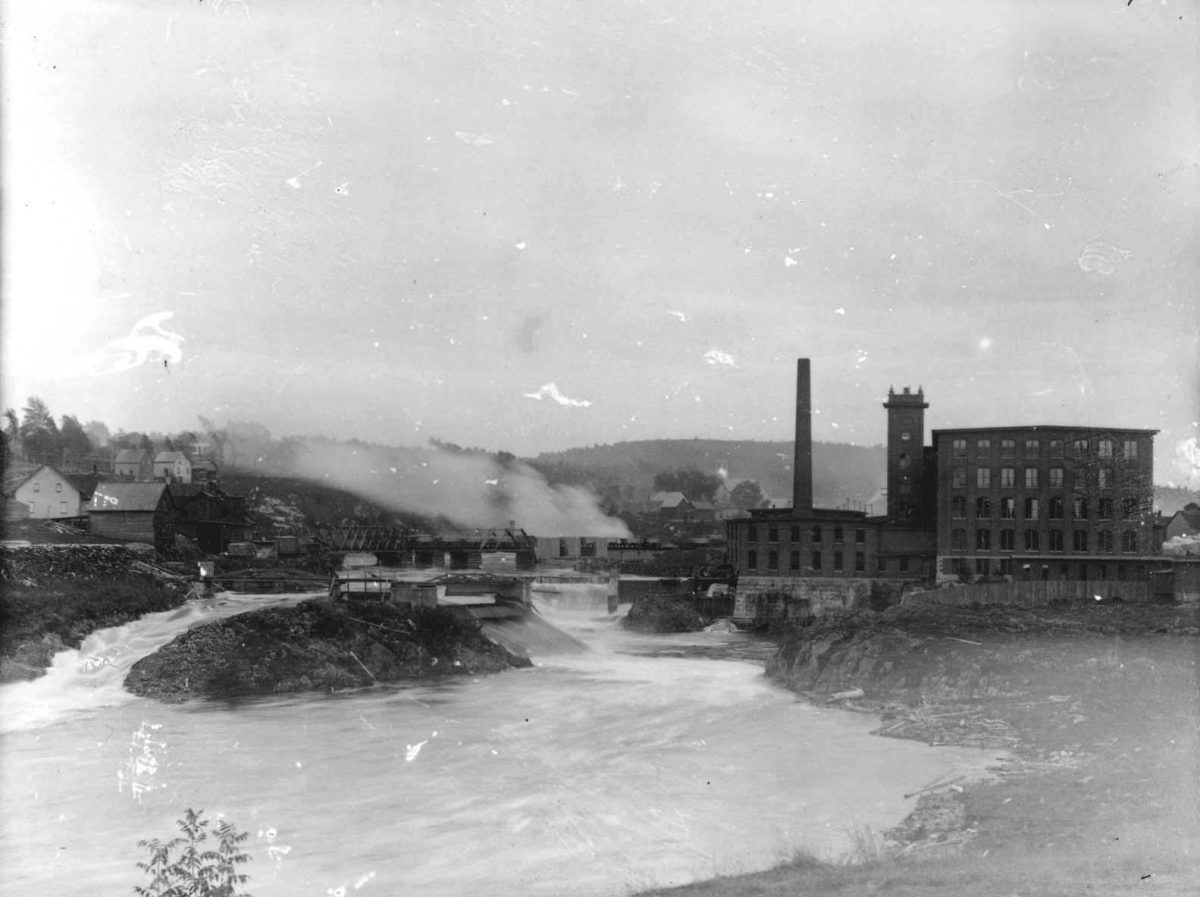
The Milltown Dam, shown here circa 1885, was built on the Skutik (St. Croix) River in 1881 to provide power to a cotton mill. Work on the removal of the dam to allow the free passage of alewives and other fishes began in the summer of 2023. Photo courtesy of the Provincial Archives of New Brunswick
Meanwhile, despite 18th-century treaties enshrining coexistence, the nation found their territory whittled out from under them. In some cases, Peskotomuhkati—in what would become Canada—were pushed off the land by the arrival of thousands of Loyalists during and after the American Revolution. Traveling throughout their territory, they’d find one location after another where they’d been displaced by settlers. By the 1950s, Peskotomuhkati were no longer counted in the Canadian census, depriving them of formal recognition—a stance that lasted until the 1990s, when the government finally agreed to talks to recognize the nation, provided they select representatives; Akagi was elected chief. (Today, there are about 350 Peskotomuhkati in Canada, and negotiations with the federal government on legal status have been inching along since 2017, though full recognition remains elusive.)
The dams built in this period diminished, but didn’t destroy, alewife passage along the Skutik. Brian Altvater Sr., a Passamaquoddy pipe carrier, says that growing up, he could still handline flounder and halibut as well as haddock and cod in Passamaquoddy Bay. They were part of the groundfish population nourished by the 2.6 million or so alewives that were still migrating up the river then. That’s a distant memory now, he says. “It’s kind of like, you have a lot of animals that are grass feeders, and you take away the grass, the whole ecosystem is going to collapse.”
The roots of that collapse can be traced to 1995, when alewife were nearly pushed over a precipice. Under pressure from the sport-fishing industry—which understood alewife as a threat to smallmouth bass, their prize target—Maine passed a law closing the fishways on the Skutik. The industry claimed alewife were invasive and linked declines in local bass populations in the 1980s to alewife presence on the Skutik. Ironically, it was smallmouth bass that had been introduced. For legislators, the narrative was persuasive nonetheless. Speaking to the House of Representatives, one Maine politician said, “You have to understand that we have piranhas in … North America. They are called alewives.”
Once passed, the law only affected the dams with fishways on American soil: Woodland and Grand Falls. Milltown remained open, as its fishway was on the Canadian side. But the closures were devastating all the same. In 2002, scientists counted 900 migrating alewives, a decline of nearly 2.5 million fish in about 20 years. In response, Canada’s federal fisheries department began moving the alewives around Woodland Dam by truck from the Canadian banks of the river—a move that angered Maine officials.
Meanwhile, alewife passage had been blocked for so long, and the river so degraded, that the nation had lost tribal and traditional memory of their presence. As a result, some tribal members had come to believe the sport fishers’ narrative that alewife didn’t belong in the river. “They were buying into what some of the [fishing] guides were telling them, that they were demonizing the alewives,” says Altvater.
Then Altvater, along with Ed Bassett, who at the time was working for the Sipayik Environmental Department, decided to take a walk.
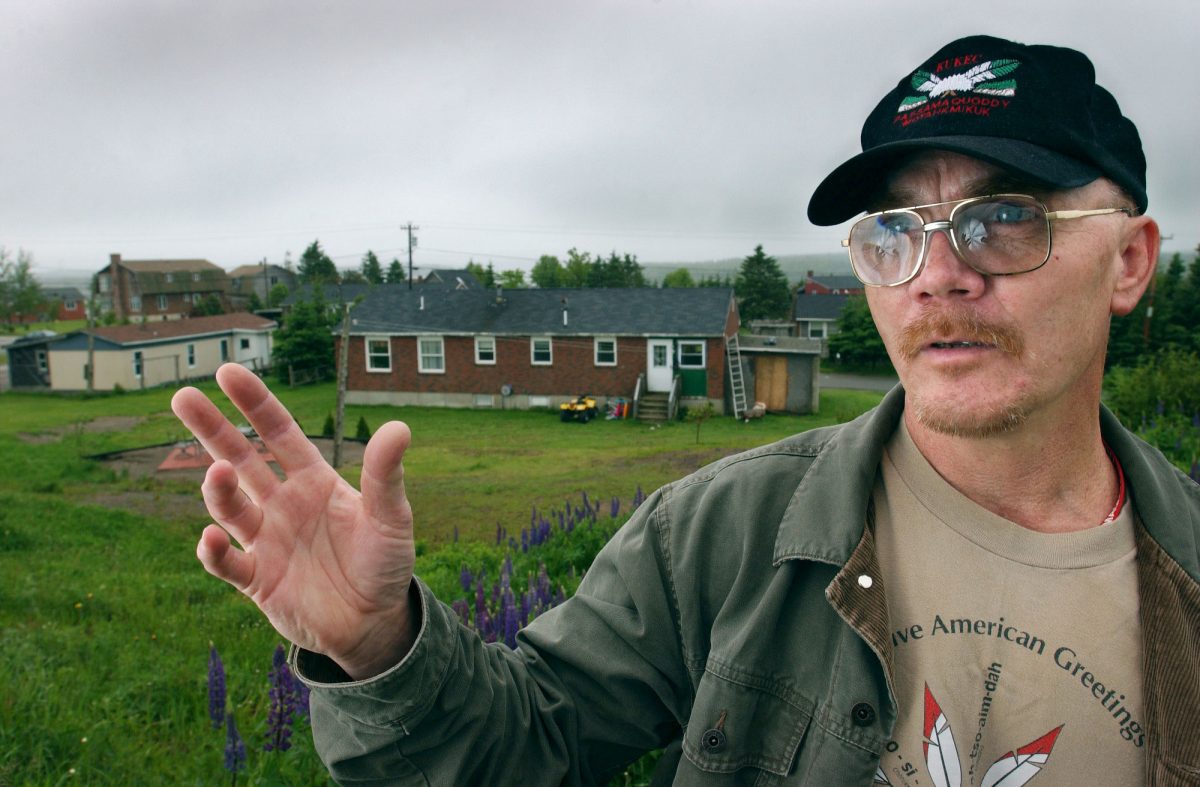
Ed Bassett of the Passamaquoddy Nation in Maine is a member of the Schoodic Riverkeepers, a group with members from the United States and Canada formed to heighten awareness about the importance of the alewife and its river habitats. Photo by Fred Field/Portland Press Herald via Getty Images
One justification sport fishers and their supporters had cited to support the characterization of alewife as invasive was the idea that fish would never have been able to pass the waterfall at Grand Falls anyway, even before the dam. But when Bassett and Altvater walked the riverbed at the site of the Grand Falls Dam with a video camera, they saw no such drop. “The way people were talking, we expected to see something like Niagara Falls,” Bassett says. “There was nothing like that.” Survey maps of the riverbank from 1912 confirmed this: the river followed a gradual slope that alewives, who are strong swimmers, could have passed. The discovery was motivating for Bassett, who, along with Altvater and a dozen other tribal members, made a video based on what they’d found at Grand Falls and the real history of the river. The video’s first three minutes were in the Passamaquoddy language—describing how the fish had fed the Passamaquoddy for millennia, and how it was the nation’s turn to return the favor. This, they hoped, would restore the cultural connection for tribal members.
“They were being misled about the river itself,” says Bassett. “The [story of the] river in the heart of Passamaquoddy territory, our ancestral river … was being manipulated by non-natives.”
Meanwhile, Chief Akagi had been approached by officials with the International Joint Commission, which since 1914 had held the mandate of resolving cross-boundary disputes on the Skutik. With scientists failing to protect the ecosystem, and Maine politicians supporting the sport-fishing industry, officials wondered if Indigenous communities could be called upon to speak for the river. Akagi told them the voice needed to come from the grassroots.
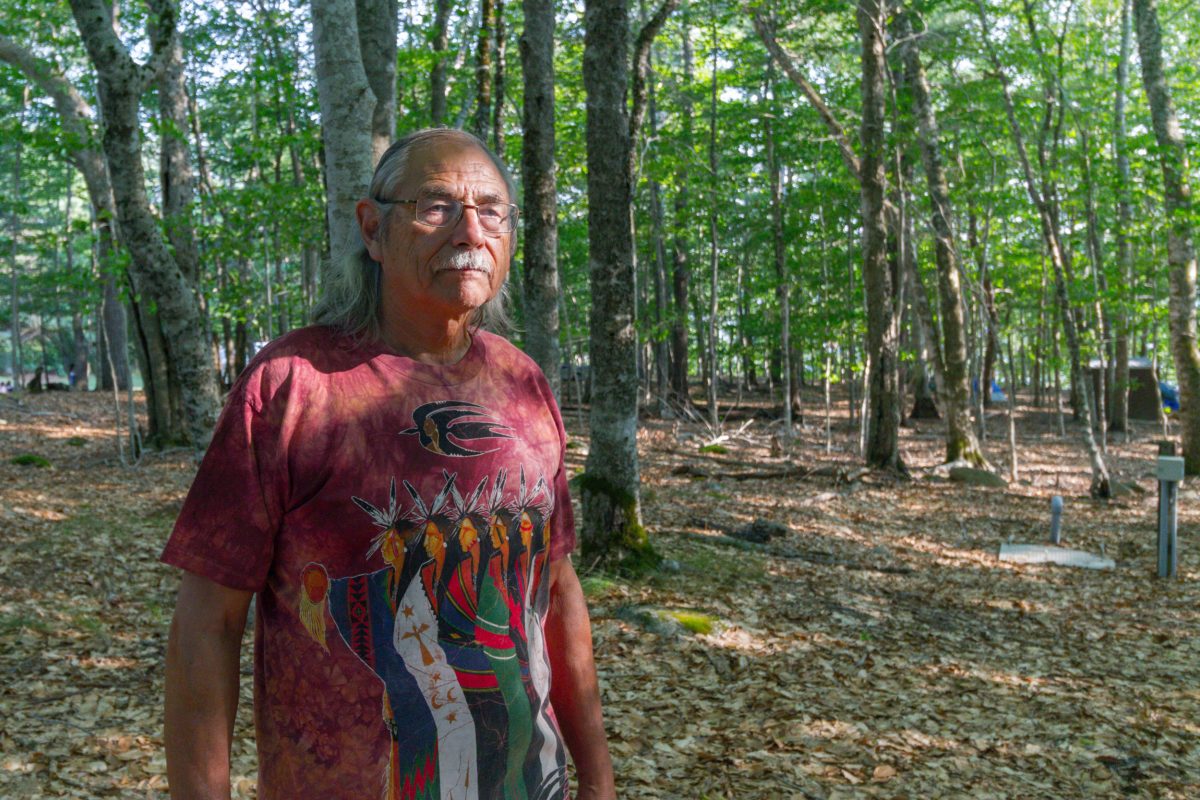
Chief Hugh Akagi of the Peskotomuhkati Nation in New Brunswick says of the Skutik, “We are defined by this river.” Photo by Stephen Brake
Akagi, along with Bassett, Altvater, and other tribal members, formed a group to speak with one voice for alewife; they would eventually call the group the Schoodic Riverkeepers. Bassett says it didn’t take much prompting from the riverkeepers to reawaken people to the fish’s importance, and in 2012, tribal leaders in Maine and New Brunswick declared a state of emergency on the river, citing the threat that declining alewife runs posed to Passamaquoddy culture. Soon after, the Passamaquoddy state representative submitted a bill to restore fish passage. “[The state] went from … ignoring us and pretending we weren’t there to having to talk to us,” says Akagi. The state of emergency had opened the proverbial floodgates. In 2013, the legislature voted by an overwhelming majority to end the blockage of the fishway. Ten days later, the law came into effect.
With the immediate threat gone, Indigenous advocates and allies could look at the bigger picture, which, though not as bad, wasn’t pretty—the same barriers that had been stunting the alewife population before the river’s closure were still a problem. “We could take a breath and be like, ‘Whoa, these are inadequate fishways, they’re falling apart,’” says Matt Abbott, who was involved in the effort to reopen the river in his role as Fundy Baykeeper with the Conservation Council of New Brunswick, which had come to comprise NGOs and scientists working alongside the Passamaquoddy. “The question was, we know this isn’t enough. How do we make this restoration bigger?”
As restoration plans go, removing the Milltown Dam was the obvious next step: it needed rehabilitation anyway—even at its peak, it only generated four megawatts of electricity—and it’s the first barrier fish face when moving upriver. This past summer, excavators began preparing the site around the dam’s concrete spillways and 19th-century red-brick power generating station, which has the look of a Victorian asylum, to begin removal. Cofferdams—enclosures that keep water out of an area—were installed upstream so that crews could demolish the spillway on the American side. With the spillway gone, water began flowing over the falls for the first time since 1881.
The formula then flipped. With cofferdams directing water through the newly restored American half of the river, demolition of the former cotton mill and generating station began. This work is set to be completed in 2024, in time for the spring alewife run. All in all, restoring this part of the river to bedrock has been painstaking—not least because, after 140 years, it was unclear what exactly was under the barrier. The demanding process highlights how removing a dam, even one that generates 0.1 percent of the power of the mammoth Revelstoke Dam in British Columbia, can’t be accomplished with the flip of a switch.
But it’s only the beginning of a plan to improve fish passage in the entire watershed, and of the journey toward restoring the river as a living system. It’s a system that includes the thousands of silvery alewives hurrying upstream—carrying nitrogen and other crucial nutrients for the ecosystem with them as they go—and the river’s other beings, like the two-meter salmon that a 10-year-old Akagi once saw his father pick up off the beach, its body so long the tail dragged on the ground as they walked. In pursuing that rehabilitation, the Passamaquoddy’s 14,000 years of calling the river home can serve as a guide: a lesson in how to live respectfully with every creature in the river.
“All we’re trying to do is get back to where we should have been. We needed to be part of the management of the system, if you will. We should never have been removed from it,” says Akagi. “And that meant that everybody else’s voice was given authority. We had no voice in our own home with the creatures that we needed to represent. So, all we’re trying to do is show others, there is another way.”
Sometimes the contours of this way are carved out by excavators punching through concrete and brick. But often it’s through smaller strokes.
Case in point: after Alewife Day has concluded, Ralph Dana pulls up to a dam on the Pennamaquan, a short distance upriver from where teenagers had been catching fish earlier in the morning. The pull-off looks like an unassuming parking lot, but “just walk a few feet and it’s like—look at these frigging fish here,” he says. “People just don’t; they miss it.”
But Dana knows the fish are here—and quickly notices something is wrong. In the L-shaped fishway built to help alewife navigate around the dam, one of the boards that would normally help control the flow has come loose, blocking the current. Without a current to direct them, addled alewife swim in useless circles against the side of the dam.
Across their range, the ecosystem that supports alewife is under significant pressure. Over the past 200 years, alewife have lost substantial spawning habitat, mainly due to dams and other barriers. This loss doesn’t always register when seen through human eyes, since the habitat itself is often still there. But from a fish’s perspective, without access, it no longer exists.
Once the Milltown Dam is gone, the next dam on the Skutik is operated by Woodland Pulp. That dam has one of the longest fishways of its kind in the world—it’s more than 200 meters long—and is in serious need of repair. (“Absolute horrendous mess,” is how Dana describes its current state.) With the Milltown Dam coming out, the remaining dam operators will no longer be able to deflect blame downstream for blocking fish passage. More than CAN $40-million is going toward improved passage, including a fish lift—a kind of watery elevator for migrating fish—to replace the dilapidated structure at Woodland.
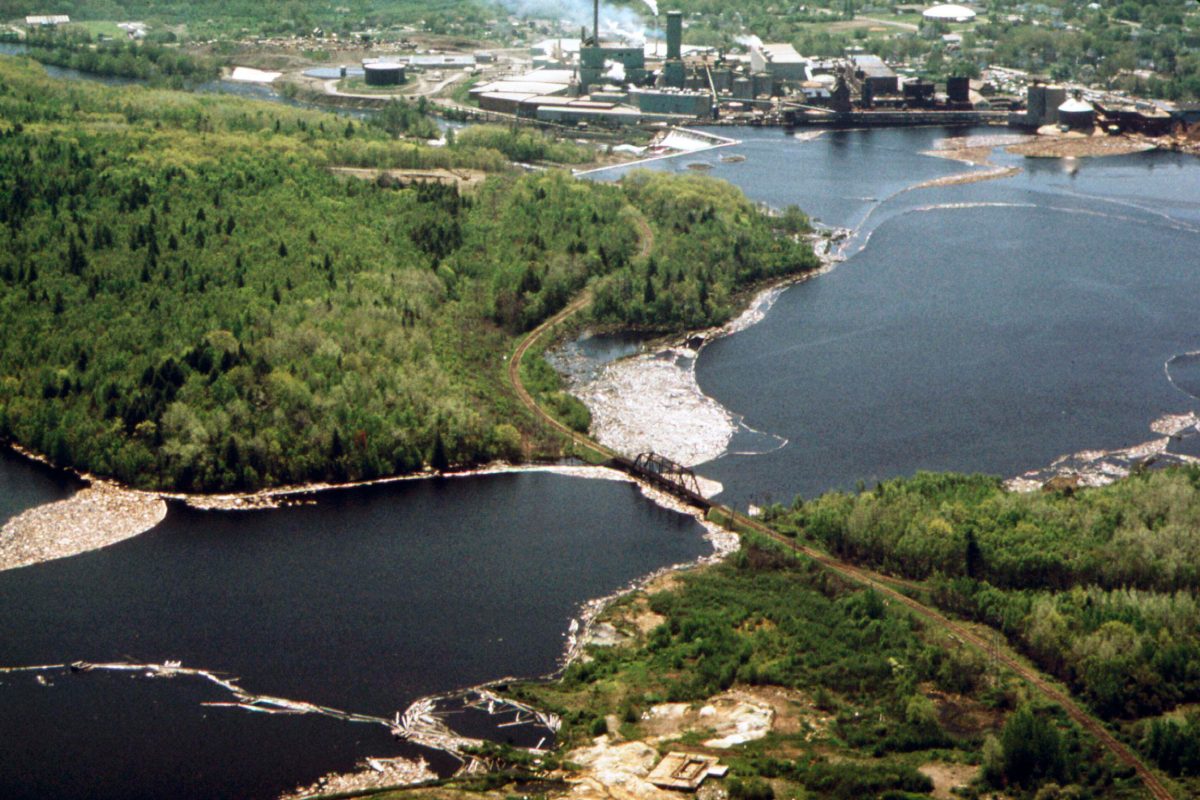
The Woodland Dam, upriver from the Milltown Dam on the Skutik (St. Croix) River, has one of the longest fishways in the world at 200 meters. The structure, shown here in the 1970s, is now in disrepair and is slated to be replaced by a fish lift to allow the passage of alewives. Photo by Hum Images/Alamy Stock Photo
On the New Brunswick side of the river, the Peskotomuhkati Nation at Skutik is tackling a range of barriers.
As part of their habitat restoration work, which is funded by Fisheries and Oceans Canada, the nation has mapped fish presence and assessed more than 2,000 culverts and other obstacles across the territory. Using that data, they’ve built a restoration plan that prioritizes addressing the most impactful barriers on the Skutik. Meanwhile, members of the stream enhancement team are consistently monitoring streams in the territory throughout the summer to make sure there are no new obstructions.
This work has informed a plan to restore the watershed, which agencies on both sides of the border have agreed to help implement. Without the Peskotomuhkati Nation at Skutik gathering this information, as well as the longstanding efforts of riverkeepers on the US side, it’s possible that the plan would not have been created, says Alexa Meyer, conservation biologist with the Passamaquoddy Recognition Group. “I don’t think any of that data would be available now, and a very, very important baseline would not exist.”
The daily work to restore the ecosystem continues on the south side of the border as well.
After removing one of the boards blocking the fishway on the Pennamaquan, Dana peers down the concrete channel. “We gotta come back,” he concludes, after spotting more debris farther down.
Walking up the fishway’s side, Dana says this upkeep is an endless task. At the moment, the tribe can tap into an influx of federal funds, but they’d be doing the work even if there were no funds. For Dana, this work is deeply tied to Passamaquoddy identity, enacting a sense of stewardship that helps the nation—with few members, surrounded by non-native communities, and, in Canada, still fighting for formal recognition—resist cultural assimilation. “If we get to a point where that relationship is no longer that important to us, that’s the end of a people.”
On both sides of the Skutik River near the Milltown Dam, the banks are carved with the infrastructure of borders: fences, guard posts, bollards. But when the dam is fully gone, this part of the river will be able to spread, no longer constrained by passage through the barrier as it flows on into the sea.
Getting to this removal was complicated by the fact that the dam sits across an international boundary; it fell to a nation not divided by that border to offer a link. Alewives needed a voice to return to the river, says Akagi. “And we identified a solution to that too: you have a people who are one people over that river. We’re not Canadian or American; we’re Peskotomuhkati.”
In other words, restoring this system has meant learning the limits of dissection—the worldview that separates organism from landscape—and instead, considering people, environments, and animals holistically, as a living system. It’s a perspective in line with the Peskotomuhkati approach.
Still, there are barriers to putting this understanding into practice. For one thing, protections for freshwater habitats don’t typically take a watershed approach. Watershed-level plans, where they exist, often come from NGOs and Indigenous groups—such as the Peskotomuhkati’s plan for the Skutik—who then have to fight to have the plans followed.
Meanwhile, Indigenous groups are working with governments who are often unfamiliar with collaborating with tribes. At one point, Dana says, he went to the town of Perry, Maine, with an offer to upgrade a problematic stream crossing—the fish would get improved passage, and the town would get a free fix for a crossing that flooded every year. “And at first they were like, ‘What’s the catch?’” Dana says. “There is no catch. This is what we do, this is how we work.”
To repair relationships damaged over centuries requires long-term commitment to the alewives that once connected the fresh water and the sea, and could do so again. “The alewife is just a start,” says Akagi. “We have to start somewhere.”
The removal of the Milltown Dam is a kind of start. But so are events like Alewife Day, where, amid the hum of teenagers scooping silvery fish from the water and crowding around picnic tables to inspect them, there’s the education of the next generation who will carry the work forward.
On that May morning, one of the youth attending lost his net downstream and crossed the river to retrieve it. Dana followed and called him over to teach him how to come back through fast-flowing water: Lean on the net. Walk into the current. Take small steps. Little by little, you’ll reach the other side.

